Folks often send us samples of common critters that they've mistaken for ticks. Although it can be difficult to differentiate whether something you've pulled off your body is a tick or a look-alike insect, it's important to arm yourself with some basic knowledge to combat your anxiety and put your mind at ease. Recognizing notable features, sizes, and even colors are some of the main factors to consider when trying to tell something apart from a tick. Being able to identify a tick, especially which species, comes with experience, but the guide below is good starting point. Take note that these are only a few bugs that resemble a tick. There are countless species of insects and arachnids that would be nearly impossible to cover in one article. However, these are the specimens people usually confuse with ticks.
-
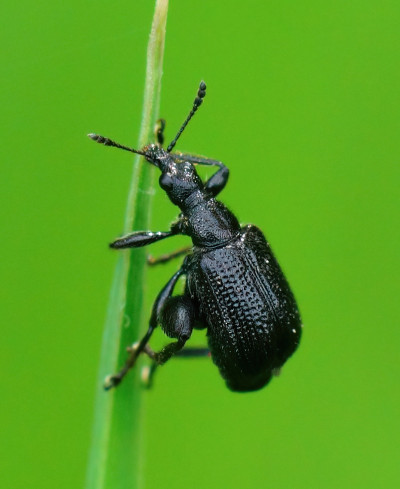
A dark birch leaf roller (Deporaus betulae).
View full-sized photo.#1 Weevil (Curculionoidea). It comes from one of the largest coleoptera families of insects. It consists of approximately 40,000 species! One of their most notable features is their elongated rostrum (snout). Keep in mind, not all weevil beetles share this feature, but most do. Another familiar feature is their spurs located on their front legs between the femur joint. Their size and appearance can greatly vary. Most range from ⅛ to ¼ inches long. They can be very dark to very brightly colored. They are also herbivores, meaning you don’t have to worry about them feeding on you or your pets' blood.
-
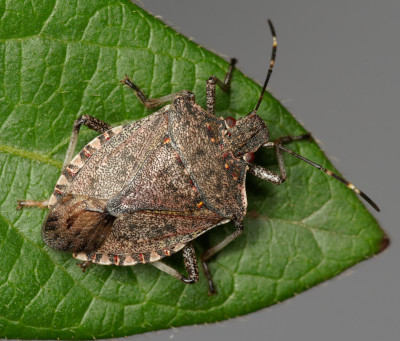
Brown marmorated stink bug (Halyomorpha halys).
View full-sized photo.#2 Brown marmorated stink bug (Halyomorpha halys). This stinky bug is an invasive species from East Asia. It was accidentally introduced to North America sometime in the mid to late 1990s. One of their most notable features are their rounded shoulders and alternating white and brown spots on the outer edges of their abdomens. Another differentiating feature you might find useful when comparing it to a tick is their dark red eyes. Their sizes range from the size of a pin-head to ½ an inch long. Color wise, the nymphs (young ones) can be cream colored or a mixture of yellow and red. The adults are usually brown with patterns.
-
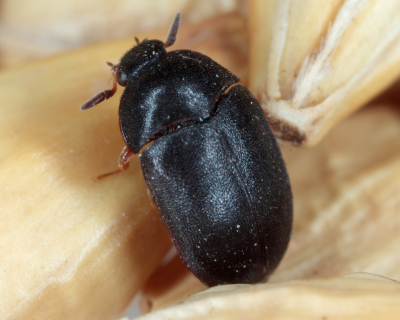
Black carpet beetle
View full-sized photo.#3 Carpet beetle (Attagenus megatoma). The carpet beetle is the most common and most destructive of the several species of carpet beetles. It likes to eat and damage household products containing keratin, synthetic fabrics, and different types of grains or cereals. Carpet beetles have very large shells that are oval shaped. It can be difficult to properly see the head while looking directly over the beetle. Their size ranges from ⅛ to ¼ inches long. They are usually dark brown or black. They do not bite humans, however, some people do develop a rash after coming into contact with one. They are scavengers so they mostly feed on dead animal products.
-

The common bed bug (Cimex lectularius)
View full-sized photo.#4 Bed bug (Cimex lectularius). These tiny bugs are famous for their infestations in hotels, schools, and homes. They are often difficult to get rid of once they reach the level of an infestation because of their resilience to the more common methods of removal. Their distinguishable feature is their flat and oval-shaped bodies. Once they feed on blood, their bodies become swollen, and their shapes become elongated. Adults are roughly 6.3mm of an inch long, while nymphs range from 1.3–4.5mm. They are a mahogany color. The bed bug is notorious for feeding on and biting humans. While ticks like to stay embedded in once place when they feed, bed bugs like to move around constantly. You can find multiple bite marks on different areas of your body.
The common bed bug (Cimex lectularius) is part of the family of cimicids (Cimicidae), which includes bat bugs. Bat bugs are small, flat, and oval-shaped. One way to distinguish it from a tick and a bed bug could be the coarse, long hairs found on their thorax. Futhermore, bat bugs are mainly found in parts of the Midwest while ticks and bed bugs are global. They are roughly 3–5mm long. Typically, they range from being dark brown to red. As their name suggests their main source of blood is from bats. They hitch rides on the skin of bats to new locations. In the absence of bats, bat bugs will blood-feed on humans and animals.
In addition to the bat bug, another cimicid is the swallow bug (Oeciacus vicarius) commonly found in cliff swallow nests, but can be seen in homes after bird migration season begins. Their bodies are completely flat. They have rounded, wide, and large abdomens. They have long hairs that cover their entire body. A key thing to look out for in their appearance are the antennae. They are equal in lengths towards the end. They are 3–4mm in size. They can be brown and reddish-brown. They mainly feed off of cliff and barn swallows. Once the birds move for migration, swallows need a new source of blood. Humans become a target if the swallow bug manages to seek asylum in your home.
-
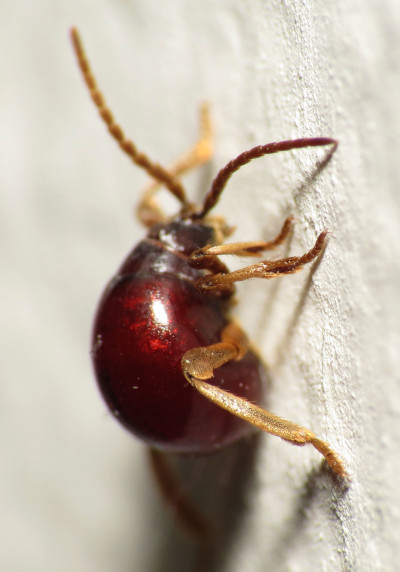
Smooth spider beetle (Periplaneta americana) by Katja Schulz licensed under CC-BY-2.0
View full-sized photo.#5 Smooth spider beetle (Gibbium aequinoctiale & Gibbium psylloides). There are numerous species of spider beetles across the globe. The smooth spider beetle is most often encountered. They are kitchen pests because they are foragers and love getting into food. They have large, round, abdomens. Their antennae and legs are very long. Its head and thorax are covered in small hairs. They are around 1.3-3.5mm. They have a glossy, dark-brown or reddish coat. They are not known to bite humans.
-

Flea
View full-sized photo.#6 Flea (Ctenocephalides felis & Ctenocephalides canis). Infamously known for its role of killing millions via the plague during the Middle Ages. Today, there are over 2,000 species of the flea. Dog and cat fleas are among the most common and pose the biggest threat to pets as well as their owners because of the diseases they can carry. They have elongated, oval-shaped hard bodies. They are thin and incredibly mobile due to this and their long, sturdy, hind legs which propel them up to 10 inches. They range from ⅛ to ¼ inches long. They are usually mahogany color or a dark red. After consuming blood, their color can darken significantly. Their main food source are animals. Humans can get bit by fleas, it's usually in a series of three bites around the ankles. Humans often are introduced to fleas through their pets who harbor them easily in their fur.
-
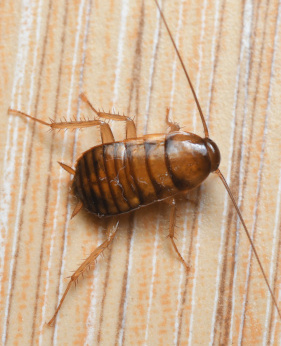
Cockroach nymph (Periplaneta americana)
View full-sized photo.#7 Cockroach nymph (Periplaneta americana). "Nymph" is a term used for insect cycles. It denotes that the insect is in a immature state. A cockroach nymph will molt (shed) about 13 times before it reaches the next stage in its life cycle. It takes roughly 13 months for the nymph to reach an adult stage. They have a long, oval-shaped appearance. Some distinguishing features would be thier long antennas as well as their long and spiny legs. They are approximately ¼ inches long in this stage. Nymphs color changes as they age. They can be grayish-brown, tan, dark brown, and reddish-brown.
-
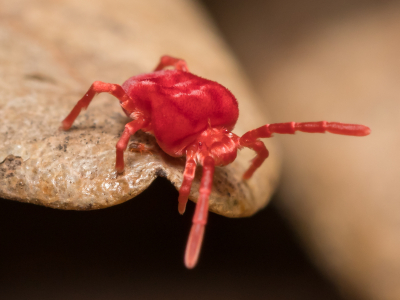
Clover mite (Bryobia praetiosa)
View full-sized photo.#8 Clover mite (Bryobia praetiosa Koch). These mites are most encountered during the Spring months and sometimes even Fall. This is mainly due to the fact that they enjoy feeding off clover and grass. They tend to conjugate on surfaces with other mites. Clover mites have front legs that are double the size of the other legs. Their long legs are often confused for antennae. They have a notable reddish-brown color. Their size ranges from 0.75–0.85mm. Although they are a nuisance, they don’t bite humans and aren’t known to carry diseases.
